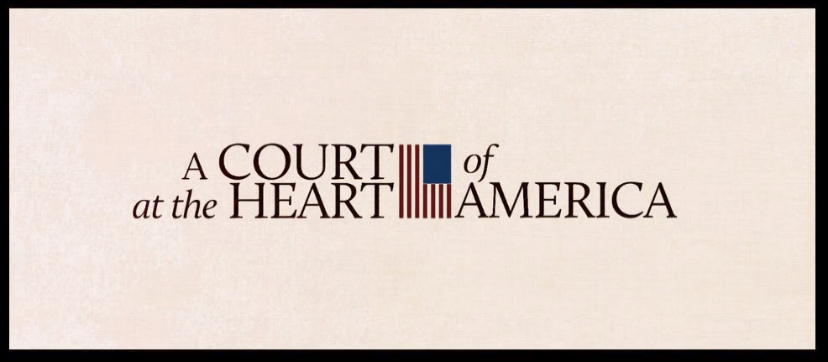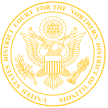
Documentary:
"A Court at the Heart of America" (Full Documentary: 57 minutes)
"A Court at the Heart of America” (Trailer: 12 minutes)
Documentary segments by topic:
Crime and Punishment: Gangs, Drugs, and Restoration (9 minutes)
Preserving Public Trust: Corruption and Politics (10 minutes)
The Heart of the Storm: Controversy, Rights, & the Rule of Law (10 minutes)
Profitability & Protection: Striking Balance for Companies and Consumers (11 minutes)
Equal Under the Law: The Long, Slow March of Civil Rights (10 minutes)
Court Lectures:
Richard Cahan and Thom Clark discussion, "The Four of Us":
AUSA Diane MacArthur, 1983 Hostage Event:
Phil Rogers of NBC:
ILND Historical Association
Visit the Court History Museum
In 1960, Congress authorized the U.S. General Services Administration to construct a new office complex in Chicago’s Loop District, consolidating over thirty agencies formerly scattered throughout the city. World-renowned architect Ludwig Mies van der Rohe served as chief designer on the project and was assisted by three Chicago architectural firms. The new U.S. Courthouse was the first of the complex’s three buildings to be completed, and its tenants occupied the new space by 1965.
Standing at 28 stories tall, the Dirksen Courthouse features a glass-enclosed great hall that spans the center of the courthouse, serving as a visual gateway through the complex. The exterior of the building, characteristic of Mies’s designs, is composed of flat black graphite-painted steel and bronze-tinted glass panes. The courthouse was designed with fifteen, two-story courtrooms located on the top ten stories of the building. Courtrooms were located away from the exterior walls to reduce audio and visual distractions. During the 1990s, additional courtrooms were created within the building in a style complimenting the original details. Such future expansion was incorporated into Mies’s initial design.
The Courthouse was renamed to honor longtime Illinois Senator Everett McKinley Dirksen after his death in 1969. Distinguished guests at the dedication ceremony in 1970 included United States Senators from Illinois Charles H. Percy and Ralph T. Smith, and Congressman John C. Kluczynski.
The Courthouse replaces the Beaux Arts Chicago Federal Building designed by Henry Ives Cobb constructed between 1898 and 1905. Bounded by Dearborn, Adams, and Clark streets, and Jackson Boulevard and topped by a dome, the building design was a six-story Greek cross over a two –story base. The building was demolished in 1965 and replaced with the current Federal Plaza.
The Stanley J. Roszkowski U.S. Courthouse in Rockford, Illinois was officially dedicated in October 2011. Covering approximately 200,000 sq. feet on 5.5 acres, the Courthouse contains five courtrooms and offices for the U.S. Courts and court-related agencies. The Courthouse features a glass atrium and a glass-enclosed jury assembly room. It is a model for sustainable design and construction and features extensive use of locally-sourced and recycled building materials. U.S. Senator Richard Durbin and U.S. Representative Don Manzullo were among the dignitaries cutting the ribbon at the Courthouse’s dedication ceremony.
Sculptor Tony Feher designed the Courthouse’s Art in Architecture composition, a forest consisting of 104 crab apple trees planted on an orchard-like grid, visually aligned to complement the architecture of the courthouse.
The Courthouse was named in honor of U.S. District Judge Stanley J. Roszkowski, who served as a judge for the U.S. District Court for the Northern District of Illinois for more than 20 years.
Another excellent resource on the history of the federal courts in Illinois is A Court that Shaped America: Chicago’s Federal District Court from Abe Lincoln to Abbie Hoffman by author Richard Cahan.
1. Al Capone
Trial Judge: James H. Wilkerson.
Date of opinion: December 20, 1937
Appellate Judge: Evan Alfred Evans
Convictions were affirmed.
Unable to get Alphonse Capone on prohibition violations, he was convicted of willful failure to file tax returns for 1928 and 1929. He was also charged with attempting to avoid income tax payments for 1925, 1926 and 1927. He was sentenced to ten years in prison and a $50,000 fine on October 24, 1931.
2. Samuel Insull
Defendants: Samuel Insull, Samuel Insull, Jr., Harold L. Stuart and 13 others
N.D. Ill. 1934
Trial Judge: James H. Wilkerson
This opinion discusses a pretrial motion that the court had no jurisdiction. Samuel Insull alleged he was kidnapped by Turkish authorities from a Greek ship and turned over to U.S. authorities, thus depriving the court of jurisdiction to try his case. Court denied the motion. The underlying case was mail fraud to defraud the public of $100 million by selling inflated stock. Samuel Insull had a large economic empire which was significantly affected by the Great Depression. He became a symbol of those who had participated in stock speculation. He was found not guilty at trial.
3. Hans Max Haupt
N.D. Ill. 1942
Trial Judge: John P. Barnes
This opinion discusses the defendant’s demurrer to the indictment. Held the indictment was sufficient to proceed to trial. A separate opinion consists of the jury charge and the sentencing portion of this case.
7th Cir. 1943 Appellate Judge: James Earl Major
First conviction of Hans Max Haupt and co-defendants was overturned as their statements were held to be inadmissible.
7th Cir. 1946, aff’d,1947
Appellate Judge: Evan Alfred Evans
Date of opinion: December 20, 1945 The second conviction of Hans Max Haupt for treason was upheld in that he assisted his son, Herbert Haupt, a German spy during World War II.
Hans Max Haupt was convicted of treason for helping his son, Herbert Haupt. Herbert Haupt was a German spy, having received training in German in sabotage and explosives. Herbert arrived in the U.S. by way of a German submarine. Ten weeks before the Chicago treason trial, Herbert Haupt was executed by a military tribunal.
4. U.S. v. Hoffa
N.D. Ill 1964
Trial Judge: Richard B. Austin
7th Cir. 1966, vacated 1967
7th Cir. 1968, conviction affirmed
Appellate Judge: Francis Ryan Duffy
Teamsters president convicted of wire fraud and conspiracy to defraud the Teamsters Pension Fund. The conviction was vacated because of government admission of unauthorized eavesdropping but upon remand it was determined that no evidence was obtained through the illegal acts.
N.D. Ill. 1967 Trial Judge: Richard B. Austin
After remand from the United States Supreme Court, defendant filed a motion for a new trial. The district judge held that the wiretapped conversations contained no relevant information to the charges. As there was no evidence that Jimmy Hoffa’s phone had ever been wiretapped, the motion for a new trial was denied.
5. Chicago Seven Trial
N.D. Ill. 1969
Defendants: Rennard C. Davis, David Dellinger, John R. Froines, Thomas H. Hayden, Abbie Hoffman, Jerry C. Rubin, Bobby G. Seale and Lee Weiner
Trial Judge: Julius J. Hoffman
7th Cir. 1972, U.S. v. Dellinger
Appellate Judge: Thomas Edward Fairchild
Date of opinion: November 21, 1972
The defendants engaged in various demonstrations at the 1968 Democratic National Convention in Chicago. They were convicted of violations of the federal Anti-Riot Act. The trial was noted for various outbursts and antics including some defendants showing up in judicial robes and the binding and gagging of Bobby Seale. In addition to many of the underlying charges, many defendants and their attorneys also had contempt of court charges pressed against them.
The Court of Appeals upheld the validity of the Anti-Riot Act but held that the voir dire was insufficient in light of the general extensive publicity and the conflicts with the police. It also held that the demeanor of the judge and prosecutors would also be grounds for reversal.
6. Greylord Trials
Defendant Richard LeFevour (Chief Judge of Cook County Traffic Court)
Trial Judge: Charles Norgle
Motion in limine regarding co-conspirator’s statements.
Defendant Harold Conn (Deputy Clerk in Cook County Traffic Court)
Trial Judge: John Nordberg
Appellate Judge: Eugene A. Wright (decision: July 30, 1985)
Defendant John M. Murphy (Assoc. Circuit Court Judge)
Trial Judge: Charles P. Kocoras
Appellate Judge: Frank Hoover Easterbrook (decision: July 19, 1985)
Defendant John Laurie (Assoc. Circuit Court Judge)
Trial Judge: Prentice H. Marshall
Laurie was acquitted on Aug. 6, 1984
Defendant John Devine (Assoc. Circuit Court Judge)
Trial Judge: Susan Getzendanner
Appellate Judge: William L. Campbell (decision: March 31, 1986)
Defendant James L. Oakey, Jr. (Assoc. Circuit Court Judge)
Trial Judge: James F. Holderman
Defendant Raymond C. Sodini (Assoc. Circuit Court Judge)
Trial Judge: James F. Holderman
Defendant Martin F. Hogan, Jr. (Assoc. Circuit Court Judge)
Trial Judge: James F. Holderman
Appellate Judge: Harlington Wood, Jr. (decision: October 13, 1989)
Operation Greylord was a massive undercover corruption investigation into the running of the Circuit Court in Cook County. The investigation started in the 1970s, with the first indictments handed down in 1983. Fifteen judges and seventy five others were indicted.
For almost 200 years, the U.S. District Court for the Northern District of Illinois is where key cases on civil rights, public corruption, organized crime, and other important issues have been decided. Famous trials include that of mob boss Al Capone, the trial of the “Chicago Seven,” the Greylord Cook County judicial corruption trials, and the trials of four Illinois governors. James Benton Parsons, the first African-American to serve as a federal judge in U.S. District Court, served in the U.S. District Court for the Northern District of Illinois, including service as the district’s chief judge.
The Northern District of Illinois Court History Museum highlights the people, places, and cases that have impacted the court, the community, and the nation through interactive video displays, listening stations, art, artifacts, and guest lectures.
Location: Everett McKinley Dirksen U.S. Courthouse
U.S. District Court, Room 2144 A
219 S. Dearborn Street
Chicago, Illinois 60604
Hours: Monday-Friday, 7 a.m.- 6 p.m., closed on federal holidays
Admission is free and open to the public.
